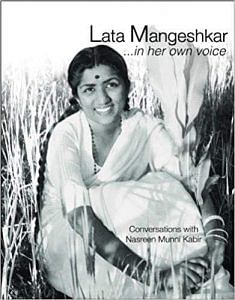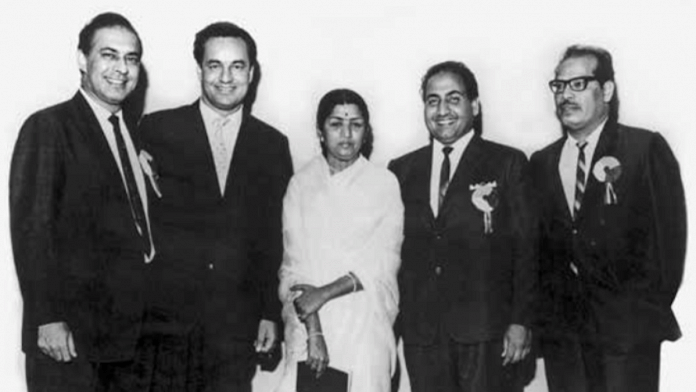In 1991, Munni Kabir had directed ‘Lata in Her Own Voice’, a six-part documentary series. Parts of this conversation are from that documentary.
Nasreen Munni Kabir (NMK): How were your working conditions?
Lata Mangeshkar (LM): I worked hard, recording songs from morning to night. Running from one studio to another. I never felt like doing anything else. I ended up going hungry all day because I didn’t even know recording studios had canteens and I could buy something to eat or get some tea. I often went without food and water for the whole day. If someone happened to mention there was a canteen in the studio, then I’d eat something. The only thought that preoccupied me was how to look after my family. Somehow.
NMK: By the early 1950s, you were singing in many films. Did anything improve on the money front?
LM: [smiles] I can’t say my financial situation was good, but neither was it bad, because I had a lot of work. We decided to stay on in the same two rooms in Nanachowk where Prafulla Pictures first housed us. I started paying rent there.
Between 1952 and 1960, we lived in a three-bedroom flat in Walkeshwar which we managed to buy. It was the first time I had a room of my own. We sold the Walkeshwar flat in 1960 and bought a first floor flat in Prabhu Kunj on Peddar Road. We have lived here ever since.
I used to give Mai all the money I earned. She ran the household and saved whatever she could. Despite the heavy workload, we weren’t always paid on time. Some producers held on to the money. Very often I wasn’t paid at all. We singers then decided we should be paid on the spot. In truth, money did not matter to me that much because the songs we sang in those days gave me so much pleasure.
In 1948, I was working on Mahal, Barsaat, Andaaz, Dulari, Badi Bahen and Girls’ School, a film whose music was composed by Anil Biswas — these films were released in 1949. So there was a lot of work and it was going well. I recorded two songs in the morning, two in the afternoon, two in the evening and two at night. I left home in the morning and got back at 3 am the next day and that’s when I ate. After a few hours sleep, I would wake up at six, get dressed, catch the train and travel from one recording studio to another. We were young, so we could work that hard. Perhaps today it isn’t possible.
Also read: Anuradha, or the musical genius of Pandit Ravi Shankar, Lata Mangeshkar and Shailendra
NMK: If you were recording so many songs in a day, how did you manage to learn them so quickly?
LM: In those days, most music directors called us to their music rooms or to a hired hall where we rehearsed the song two or three times prior to the recording session. So, on any given day, we were ready to record, say two songs by Naushad Sahib or Anil Biswas. But the songs were always rehearsed in advance.
NMK: Were playback singers given any special status in those days?
LM: No! No importance at all was given to playback singers. Producers would think: ‘Let them record, pay them and they can go.’ End of story. I don’t know if you’ve seen the 78 record of ‘Aayega aanewala.’ Well, the singer’s name on the label is ‘Kamini.’ It was Madhubala’s screen name in Mahal. I did get upset that our names never featured anywhere. I had to fight for it to happen and kept asking producers: ‘Why don’t you credit us?’ The first time our names appeared on the screen and on disc was in Barsaat in 1949. It coincided with credit given to us in other films that year, including Andaaz and Badi Bahen. ‘Aayega aanewala’ became so popular that the radio station received thousands of request letters. People wrote in asking: ‘Who is singing this song? We want to know her name.’ So HMV was called and asked to name the singer. Finally it was even announced on the radio: ‘This song is sung by Lata Mangeshkar.’ [smiles]
Also read: On Lata Mangeshkar’s birthday, 15 rare gems that belong on her crown
NMK: Interesting how you had to fight to become ‘visible.’ Gulzar Sahib once said that it was Sahir Ludhianvi who insisted that the names of the lyricists be announced on All India Radio alongside the names of the composers.
I am curious to know what the recording studios were like in the 1940s and 1950s.
LM: There weren’t many in those days. Famous and Central were in Tardeo, and there was another studio also called Famous which was in Mahalakshmi. These studios had small halls used for recording. Filmistan in Goregoan had a small recording studio too, but on many occasions, we were obliged to record on the studio floor. Even the songs of Filmistan’s own productions, Nagin and Anarkali, which were hugely successful films, were recorded on a studio stage.
When the day’s shooting finished and everyone had left, we went onto the studio floor and recorded through the night. The place was full of dust, the lights were still burning hot and it was sweltering. We couldn’t use the fans because of the noise they made. I have recorded so many songs in difficult and trying conditions.
 This excerpt from ‘Lata Mangeshkar…in her own voice’ in conversation with Nasreen Munni Kabir has been published with permission from Niyogi Books.
This excerpt from ‘Lata Mangeshkar…in her own voice’ in conversation with Nasreen Munni Kabir has been published with permission from Niyogi Books.







True Patriot, Jai Hind respected Honorable Lataji. You share your birthday with my Mother. A life full of Sacrifices. A True Legend.
I think Lata didi is idol of every indian. Her voice, her behaviour, her dedication towards work is symbolic of indian culture.
Whole mangeshkar family , they are Gandharv take birth on earth.
Lata Didi we salute your songs which is all the time so good
What percentage of the fees paid to the music director was received by the singer.
Why did Muhammed Rafi oppose the demand by other singers to increase their share of fees paid by the producer.
To hear story of lata I had tears in my eyes. Fortune comes by dint of hard work sacrifices passion n perseverance n determination. There is no substitute for hardwork